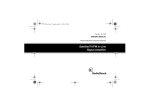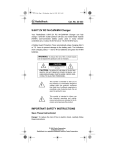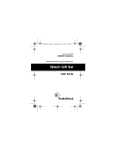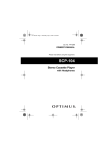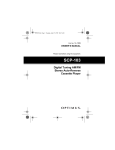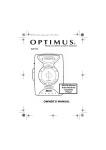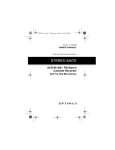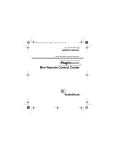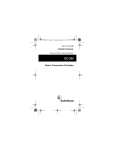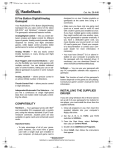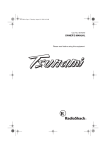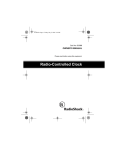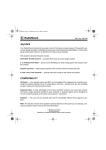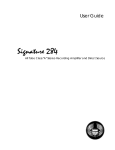Download Panasonic 32-1222 Microphone User Manual
Transcript
32-1222.fm Page 1 Tuesday, July 6, 1999 4:03 PM Cat. No. 32-1222 OWNER’S MANUAL Please read before using this equipment. 2-Channel 170-MHz Wireless FM Microphone System 32-1222.fm Page 2 Tuesday, July 6, 1999 4:03 PM FEATURES Your Optimus 2-Channel 170 MHz Wireless FM Microphone System is designed for use with public address systems, musical instrument amplifiers, or other audio systems. The system’s long range (about 150 feet) lets you use it anywhere you would use a conventional microphone. Its features include: Two Handheld Microphones — with each microphone on a separate channel, two people can speak or perform at the same time without microphone interference. Low Battery Indicator — helps you avoid last-minute battery failures. WARNING: To reduce the risk of fire or shock hazard, do not expose this product to rain or moisture. CAUTION RISK OF ELECTRIC SHOCK. DO NOT OPEN. CAUTION: TO REDUCE THE RISK OF ELECTRIC SHOCK, DO NOT REMOVE COVER OR BACK. NO USERSERVICEABLE PARTS INSIDE. REFER SERVICING TO QUALIFIED PERSONNEL. Separate Volume Controls — let you easily balance the system receiver’s output with other sound sources. This symbol is intended to alert you to the presence of uninsulated dangerous voltage within the product’s enclosure that might be of sufficient magnitude to constitute a risk of electric shock. Do not open the product’s case. Compander Noise Reduction — improves the signal to give you the best possible sound. Audio and Line Outputs — let you easily connect to any amplifier, mixing board, or recorder, and you can use both outputs at the same time. Standby Switch — lets you turn off the microphone without turning off the microphone’s transmitter, thus avoiding a loud pop when you turn the microphone back on. ! This symbol is intended to inform you that important operating and maintenance instructions are included in the literature accompanying this product. © 1999 Tandy Corporation. All Rights Reserved. Optimus and RadioShack are registered trademarks used by Tandy Corporation. 2 ! 32-1222.fm Page 3 Tuesday, July 6, 1999 4:03 PM FCC NOTICE This wireless microphone system complies with Part 90 of FCC Rules. There are two frequencies available for the system. You must get a license for each frequency you plan to use before you use the system (one license can include both frequencies). Licensability depends on how you will use the system. Look in your local phone book for the nearest FCC office and contact them to get the necessary application. SETTING UP THE SYSTEM Your system has two channels for transmitting. Each microphone has a sticker with a letter on it to help you determine which microphone is which. Microphone 1 (MIC 1) is marked A, D, or B. Microphone 2 (MIC 2) is marked E, G, or H. You can combine up to three separate systems so you can use up to six microphones together (each with a different frequency). Installing the Transmitter’s Battery Cautions: • Use only fresh batteries of the required size and recommended type. • Do not mix old and new batteries, different types of batteries (standard, alkaline, or rechargeable), or rechargeable batteries of different capacities. Follow these steps to install each battery. 1. While holding the microphone’s handle, carefully unscrew the windscreen far enough to remove the battery door. Battery Door Windscreen 2. Install the battery into the battery compartment on top of the ribbon, being sure the + and – terminals touch the appropriate contacts as marked inside the compartment. Be sure to firmly press the battery in place. Cat. ® FC C ID : AA TWO-C FM A DIVISION 17 0MHz HONE SUPPLY: S TANDYCORPORATION, WIRELES SYS 1 X "9V" IN OF No.3 2-1222 O 3 2 0 1 2 2 2 HANNEL MICROP POWER CUSTOMMANUFACTURED CHINA S TEM BATT FOR . RADIOSHACK, FORTWORTH, TEXAS76102 Each microphone transmitter requires a 9-volt battery (not supplied) for power. For the best performance and longest life, we recommend an alkaline battery, available at your local RadioShack store. 3 32-1222.fm Page 4 Tuesday, July 6, 1999 4:03 PM 3. Replace the battery compartment cover and tighten the windscreen. If the battery power is low, the red BATT LOW indicator lights when the microphone’s switch is set to ON or STBY (standby). Replace the battery. AAO3201222 To use the AUDIO jack, connect a shielded audio cable’s mono 1/4-inch phone plug to the receiver’s AUDIO jack. Connect the other end to a microphone-level input on your amplifier, mixer, or tape recorder. AA Connecting the Power Adapter The receiver operates from standard AC power, using the supplied 12-volt DC power adapter. Warning: Dispose of old batteries promptly and properly. Never burn or bury them. Caution: If you do not plan to use the microphone for a week or more, remove the battery. Batteries can leak chemicals that can damage electronic parts. Connecting the Receiver to an Amplifier, Mixer, or Tape Recorder Connect the receiver to an amplifier, mixer, or tape recorder using either the receiver’s LINE or AUDIO output jack. To use the LINE jack, connect a shielded audio cable’s phono plug to the receiver’s LINE jack. Connect the other end to a line-level input on your amplifier, mixer, or tape recorder. Cautions: • Use only the supplied adapter. If you lose or damage this adapter, order a replacement from your local RadioShack store. Using other adapters could damage the receiver. • Always plug the adapter into the receiver before you plug it into the AC outlet. Always unplug the adapter from the outlet before you unplug it from the receiver. 1. Turn off the receiver by pressing POWER until the button is in the outmost (off) position. 2. Plug the adapter’s barrel plug into the receiver’s DC 12V jack, then route the cord through the strain relief. LINE AUDIO DC 12V 100m A (MA X) Strain Relief 4 32-1222.fm Page 5 Tuesday, July 6, 1999 4:03 PM 3. Plug the adapter into a standard AC outlet. OPERATION Note: Leave the microphone’s slide switch set to STBY or ON whenever the receiver is on. This keeps the system from producing a loud hiss. 2 1 2 CH SIO OFES L PR ANNE MIC IVER RECE 2 MIC LESS 1 WIRE MIC NAL VOLU ME MAX OFF MAX OFF R POWE 1. Fully extend the receiver’s antenna. 2. Turn on your tape recorder, amplifier, mixing board, and other necessary audio components. Set their volume controls (or input level controls) to moderate settings. 3. If you plan to use both wireless microphones, turn both the receiver’s MIC VOLUME controls clockwise until they click on. (If you plan to use only one microphone, turn on only the appropriate control.) Position each control at its lowest setting. 4. Press POWER to turn on the receiver. The power indicator lights. 5. Set the microphone transmitter’s slide switch to STBY or ON. The receiver’s MIC 1 or MIC 2 indicator lights, depending on which microphone you turn on. If your microphone is marked A, D, or C, the MIC 1 indicator lights. If your microphone is marked E, G, or H, the MIC 2 indicator lights. 6. If you are using a separate audio source (such as a tape deck or CD player) with your audio system, turn on the audio source and adjust the receiver’s MIC VOLUME controls for the best volume and balance. Note: For the best results, experiment with the receiver’s MIC VOLUME settings and the volume settings of other components in your audio system. If you are using a source that has a variable output control, such as a musical instrument, be sure you adjust the volume with the instrument at the highest level you intend to use. Using the Standby Setting The microphone transmitter’s STBY setting lets you turn off the microphone without turning off its transmitter. If you move the switch from OFF to STBY or ON, you will hear a loud pop. Use the STBY setting to avoid this sound. There should be virtually no sound when you slide the switch from STBY to ON. If you set the switch to OFF while your audio system is on, there may be a loud hiss. There is no hiss when you set the switch to STBY. To conserve battery power, be sure to set the switch to OFF when you finish using the microphone transmitter. 5 32-1222.fm Page 6 Tuesday, July 6, 1999 4:03 PM CARE AND MAINTENANCE Your Optimus 2-Channel 170 MHz Wireless FM Microphone System is an example of superior design and craftsmanship. The following suggestions will help you care for your system so you can enjoy it for years. Keep the system dry. If it gets wet, wipe it dry immediately. Liquids might contain minerals that can corrode the electronic circuits. Use and store the system only in normal temperature environments. Temperature extremes can shorten the life of electronic devices, damage batteries, and distort or melt plastic parts. Keep the system away from dust and dirt, which can cause premature wear of parts. Handle the system gently and carefully. Dropping it can damage circuit boards and cases and can cause the system to work improperly. Use only fresh batteries of the required size and recommended type. Batteries can leak chemicals that damage your system’s electronic parts. Wipe the system with a damp cloth occasionally to keep it looking new. Do not use harsh chemicals, cleaning solvents, or strong detergents to clean the system. Modifying or tampering with the system’s internal components can cause a malfunction and might invalidate its warranty and void your FCC authorization to operate it. If your system is not performing as it should, take it to your local RadioShack store for assistance. 6 32-1222.fm Page 7 Tuesday, July 6, 1999 4:03 PM SPECIFICATIONS Transmitter Sensitivity: Microphone Input ................................................................. 100 dB SPL ±5 dB Frequency Response ......................................................................... 100–8,000 Hz RF Output Power .......................................................................................... 18 mW (Terminated at 50 Ohm Load) Current Consumption ................................................................... 38 mA (Average) Battery Life (Alkaline) ................................................................. 8 Hours (Average) Operating Frequencies: Groups Microphone 1 Microphone 2 1 A — 169.445 MHz E — 171.045 MHz 2 D — 170.305 MHz G — 171.845 MHz 3 B — 169.505 MHz H — 171.905 MHz Receiver Sensitivity ......................................................................... 2 µV (with S/N @ 20 dB) S/N Ratio (@ 1mV Input) ........................................................... 82 dB, A-Weighted Output Power: LINE ...................................................................................................... 250 mV AUDIO ..................................................................................................... 16 mV Total Harmonic Distortion .................................................................. 1.0% (Typical) Power Requirements .............................................................. 12 Volts DC, 100 mA Operating Frequencies: Groups Microphone 1 Microphone 2 1 A — 169.445 MHz E — 171.045 MHz 2 D — 170.305 MHz G — 171.845 MHz 3 B — 169.505 MHz H — 171.905 MHz Specifications are typical; individual units might vary. Specifications are subject to change and improvement without notice. 7 32-1222.fm Page 8 Tuesday, July 6, 1999 4:03 PM Limited One-Year Warranty This product is warranted by RadioShack against manufacturing defects in material and workmanship under normal use for one (1) year from the date of purchase from RadioShack company-owned stores and authorized RadioShack franchisees and dealers. EXCEPT AS PROVIDED HEREIN, RadioShack MAKES NO EXPRESS WARRANTIES AND ANY IMPLIED WARRANTIES, INCLUDING THOSE OF MERCHANTABILITY AND FITNESS FOR A PARTICULAR PURPOSE, ARE LIMITED IN DURATION TO THE DURATION OF THE WRITTEN LIMITED WARRANTIES CONTAINED HEREIN. EXCEPT AS PROVIDED HEREIN, RadioShack SHALL HAVE NO LIABILITY OR RESPONSIBILITY TO CUSTOMER OR ANY OTHER PERSON OR ENTITY WITH RESPECT TO ANY LIABILITY, LOSS OR DAMAGE CAUSED DIRECTLY OR INDIRECTLY BY USE OR PERFORMANCE OF THE PRODUCT OR ARISING OUT OF ANY BREACH OF THIS WARRANTY, INCLUDING, BUT NOT LIMITED TO, ANY DAMAGES RESULTING FROM INCONVENIENCE, LOSS OF TIME, DATA, PROPERTY, REVENUE, OR PROFIT OR ANY INDIRECT, SPECIAL, INCIDENTAL, OR CONSEQUENTIAL DAMAGES, EVEN IF RadioShack HAS BEEN ADVISED OF THE POSSIBILITY OF SUCH DAMAGES. Some states do not allow the limitations on how long an implied warranty lasts or the exclusion of incidental or consequential damages, so the above limitations or exclusions may not apply to you. In the event of a product defect during the warranty period, take the product and the RadioShack sales receipt as proof of purchase date to any RadioShack store. RadioShack will, at its option, unless otherwise provided by law: (a) correct the defect by product repair without charge for parts and labor; (b) replace the product with one of the same or similar design; or (c) refund the purchase price. All replaced parts and products, and products on which a refund is made, become the property of RadioShack. New or reconditioned parts and products may be used in the performance of warranty service. Repaired or replaced parts and products are warranted for the remainder of the original warranty period. You will be charged for repair or replacement of the product made after the expiration of the warranty period. This warranty does not cover: (a) damage or failure caused by or attributable to acts of God, abuse, accident, misuse, improper or abnormal usage, failure to follow instructions, improper installation or maintenance, alteration, lightning or other incidence of excess voltage or current; (b) any repairs other than those provided by a RadioShack Authorized Service Facility; (c) consumables such as fuses or batteries; (d) cosmetic damage; (e) transportation, shipping or insurance costs; or (f) costs of product removal, installation, set-up service adjustment or reinstallation. This warranty gives you specific legal rights, and you may also have other rights which vary from state to state. RadioShack Customer Relations, 200 Taylor Street, 6th Floor, Fort Worth, TX 76102 We Service What We Sell 04/99 RadioShack A Division of Tandy Corporation Fort Worth, Texas 76102 07A99 811081800A Printed in China








